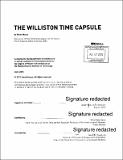| dc.contributor.advisor | Miho Mazereeuw. | en_US |
| dc.contributor.author | Moses, David (David Patrick) | en_US |
| dc.contributor.other | Massachusetts Institute of Technology. Department of Architecture. | en_US |
| dc.coverage.spatial | n-us-nd | en_US |
| dc.date.accessioned | 2015-10-14T15:01:52Z | |
| dc.date.available | 2015-10-14T15:01:52Z | |
| dc.date.copyright | 2015 | en_US |
| dc.date.issued | 2015 | en_US |
| dc.identifier.uri | http://hdl.handle.net/1721.1/99262 | |
| dc.description | Thesis: M. Arch., Massachusetts Institute of Technology, Department of Architecture, 2015. | en_US |
| dc.description | Cataloged from PDF version of thesis. | en_US |
| dc.description | Includes bibliographical references (page 15). | en_US |
| dc.description.abstract | This project is a time capsule of the oil economy, created by entombing everyday objects made from and powered by petroleum into a landscape that spatially recreates the processes of drilling and fracking a contemporary oil well. It consists of two interrelated landscape systems. The first is a giant landform, a marker on the earth's surface commensurate with the scale of the second, a labyrinth of chambers carved out of a subterranean strata of rock. The site is an existing two square mile drill spacing unit on the edge of Williston, North Dakota, in the middle of one of the largest contemporary shale oil booms in the world. This thesis aspires to be a counter monument to the processes that create massive change on a territorial scale yet somehow remain hidden from the end consumers of those processes. By placing the objects of oil back underground in their place of origin, they become future sites of meditation on the ways that everyday consumption drives the economies of extraction. Their entombment takes place over a long period of future time: as objects and processes of the oil economy become obsolete, they are buried one by one, a long slow motion fracking of the site. Like most monuments, this one has been designed for a future public, hopefully one that wonders at the strangeness of us and our economies of frenzied extraction and consumption. The thesis is a way of saying that we as a culture at least contended with fracking and its innumerable consequences in way that was more substantial than simply worrying about the price of gas at the pump. | en_US |
| dc.description.statementofresponsibility | by David Moses. | en_US |
| dc.format.extent | 121, 1 unnumbered pages | en_US |
| dc.language.iso | eng | en_US |
| dc.publisher | Massachusetts Institute of Technology | en_US |
| dc.rights | M.I.T. theses are protected by copyright. They may be viewed from this source for any purpose, but reproduction or distribution in any format is prohibited without written permission. See provided URL for inquiries about permission. | en_US |
| dc.rights.uri | http://dspace.mit.edu/handle/1721.1/7582 | en_US |
| dc.subject | Architecture. | en_US |
| dc.title | The Williston time capsule | en_US |
| dc.type | Thesis | en_US |
| dc.description.degree | M. Arch. | en_US |
| dc.contributor.department | Massachusetts Institute of Technology. Department of Architecture | |
| dc.identifier.oclc | 922640899 | en_US |
